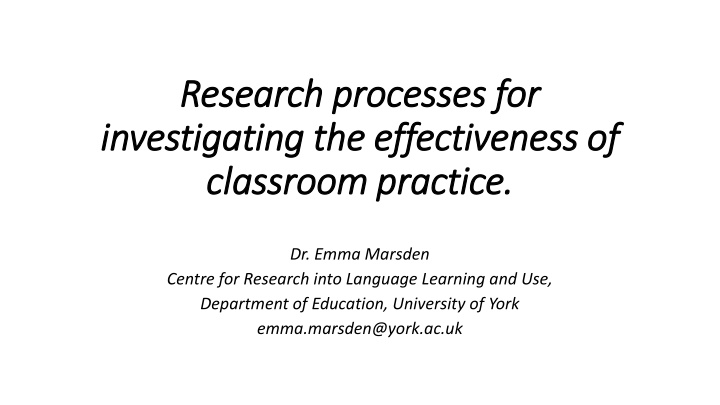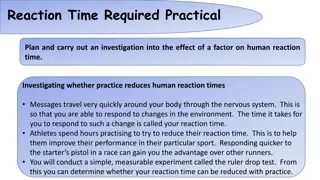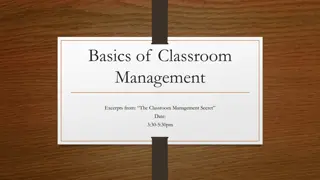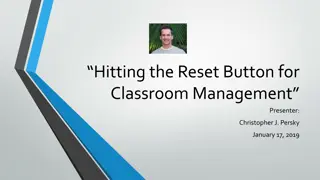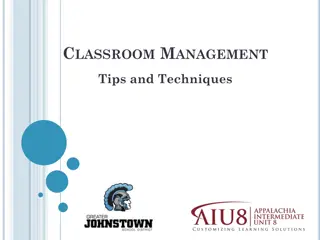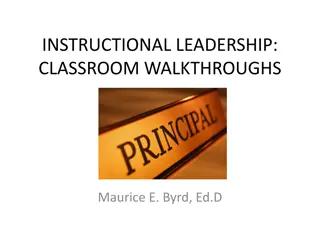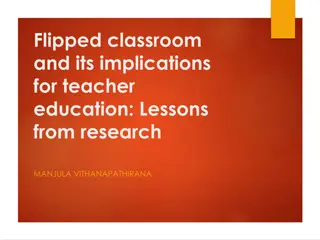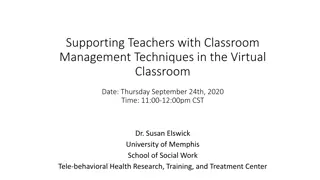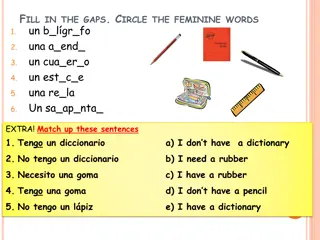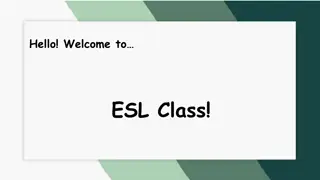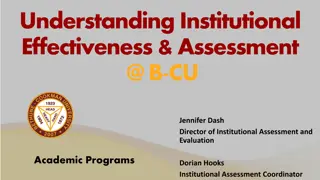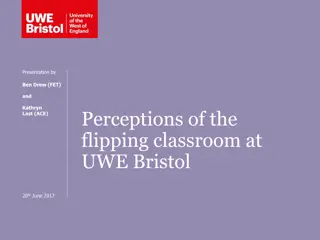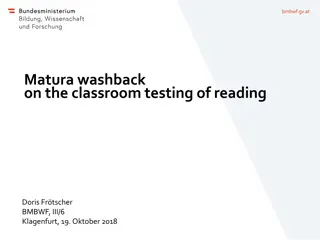Investigating Classroom Practice Effectiveness
Research processes for investigating the effectiveness of classroom practice involve formulating focused research questions, building on previous studies, and avoiding yes/no inquiries. Dr. Emma Marsden from the University of York emphasizes the importance of reproducible methods and documented results. Examples of research topics include autonomy, project-based learning, speaking practice, and flipped classrooms, with research questions designed to explore specific relationships or phenomena in language learning contexts.
Download Presentation

Please find below an Image/Link to download the presentation.
The content on the website is provided AS IS for your information and personal use only. It may not be sold, licensed, or shared on other websites without obtaining consent from the author.If you encounter any issues during the download, it is possible that the publisher has removed the file from their server.
You are allowed to download the files provided on this website for personal or commercial use, subject to the condition that they are used lawfully. All files are the property of their respective owners.
The content on the website is provided AS IS for your information and personal use only. It may not be sold, licensed, or shared on other websites without obtaining consent from the author.
E N D
Presentation Transcript
Research processes for Research processes for investigating the effectiveness of investigating the effectiveness of classroom practice. classroom practice. Dr. Emma Marsden Centre for Research into Language Learning and Use, Department of Education, University of York emma.marsden@york.ac.uk
Research A noun: scholarly or scientific investigation or inquiry A verb: to study (something) thoroughly (American Heritage College Dictionary, 2000) every day we ask questions, come up with hypotheses, and seek confirmation of those hypotheses (Mackey & Gass 2005, p.1) Planned (and often systematic) Different to normal practice How you did it (methods) should be reproducible Process and results formally documented
Formulating Research Questions Research topics include: Autonomy Project-based learning Speaking practice Flipped classrooms The impact of extended reading on learning But, research questions are more focused Focus, focus, focus Express the relationships or phenomena you are going to explore Answerable
Formulating research questions for classroom research Read some previous research to understand the history behind current issues DON T JUST RELY ON PERSONAL EXPERIENCE (THOUGH HELPFUL). Try to build on this research Even replicate it. Use the same materials, or adapt them You can then compare your findings to the previous research
Formulating research questions Try to avoid YES / NO questions (Do . Is there ) Instead, use To what extent does What kinds of factors influence What is the nature of What is the frequency of Comparing x approach to y approach, which has the most benefit for the learning of
One research project could focus on ONE of the following very broad, MAIN research questions: As a GROUP, you could focus on one related project together! -> More data on a similar issue RQ What is the nature of autonomy in language learning in English for Academic Purposes classes? (exploratory) RQ To what extent does a flipped classroom change learners reported autonomy? (causal) RQ What are students attitudes towards oral communication activities in the classroom? (exploratory)
Research questions can be more detailed or have sub (more details about the phenomena, relations, correlations, causes) Autonomy sub- -questions questions a) To what extent does proficiency influence autonomy? lecture recordings vs texts to read vs short quizzes b) To what extent does the subject discipline of the student affect autonomy? Flipped classroom a) To what extent is learners existing autonomy associated with their attitudes towards a flipped classroom approach? b) To what extent does students reported amount of use of pre-class materials depend on the type of materials? c) To what extent does students reported nature of use of pre-class materials depend on the type of materials? Oral communication a) To what extent does the amount of teachers use of English relate to students reported willingness to communicate in the classroom? b) To what extent does the type of teachers use of English relate to students reported willingness to communicate in the classroom?
Hypotheses? Research questions are the questions for which answers are being sought, whereas research hypotheses can be used to express what the researcher expects the results of the investigation to be. The hypotheses are based on observations or on what the literature suggests the answers might be (Mackey & Gass, 2005: 19) =more precise predictions about what you will find Not always necessary or possible Nondirectional hypothesis e.g. There will be differences in autonomy between learners of different proficiencies Directional hypothesis e.g. More proficient learners will be more autonomous than less proficient learners.
Key terms in research Key terms in research Empirical Collecting data, from learners, teachers and from texts e.g. from textbooks, policy documents Research Synthesis: data from research reports (articles) Literature reviews: narrativeversussystematic reviews Meta-analysis = average effect sizes or other kinds of data, drawn from several primary studies Theoretical or think-pieces or position pieces Grounded very heavily in previous literature no new data collected! Qualitative -> constructs, themes and categories will emerge from your data Quantitative -> the constructs under investigation have been decided in advance of data collection, so you can count instances of these constructs via pre-determined codes and categories. Research aims and designs: Documenting the teaching or the learning, as it is in process (sometimes: Process studies ) Documenting knowledge or skills of learners or of teachers (sometimes: Product studies ) Investigating relationships between teaching and learning (sometimes: Process-Product studies ) Longitudinal versus cross-sectional Within-subject versus between-subject
Research designs and approaches for looking at teaching, learning, and relations between them For investigating the teaching OR learning (process) E.g. Observations, interviews, questionnaires, think-alouds, stimulated recalls, keystroke monitoring For investigating what has been learnt, state of knowledge or skill (product) E.g. Language tests (speaking, listening, reading, writing, grammar, vocabulary, pronunciation, processing etc.) and also as above! For investigating the relations between teaching and learning (process-product) Correlational designs associations between one variable and another Experimental designs manipulate what different learners experience and measure outcomes Interventions or naturalistic Pre-post designs Quasi-experimental (no randomisation) True experimental (matched or complete randomisation)
Research design for looking at the effect of teaching on learning Research design for looking at the effect of teaching on learning The only research method that can adequately control for external confounding factors (and therefore measure the small educationally important changes that may result from educational innovations or changes in policy) is the randomised controlled trial (RCT) (Torgerson & Torgerson, 2001 See Marsden, 2005. Can experimental designs inform both theory and practice? British Educational Research Journal Marsden & Torgerson, 2012. Pre-post designs. Oxford Review of Education) RCT Students (quasi-) randomly allocated to different treatments/teaching approaches Can be experimental versus business as usual (non-active control) or comparison Baseline measures taken (normally) Outcome measures taken
REPLICATION! Using or directly based on the aims, design and materials of previous research (Porte, 2012) Conducting a research study again, in a way that is either identical to the original procedure or with small changes (e.g., different participants), to test the original findings (Mackey & Gass, 2005: 364) 1 Conceptual replication Same/similar aims, but different design and materials (e.g. outcome measure) 2 Partial or approximate replication Same aims, perhaps different in one or more of: sample (e.g. language, proficiency, age) some materials analysis 3 True replication Same aims, same design, same materials, same/similar sample, same analysis
But, where would I find materials to help me?
2320 files -> over 1100 data collection instruments new materials contributed almost daily From 1229 researchers Searchable across 330+ parameters, research area type of instrument language feature L1, L2 participant characteristics: age, proficiency author Materials qualify for IRIS if used for peer-reviewed publications or PhDs
Submission to IRIS supported by 37 journals In author guidelines and acceptance letters Upload to IRIS in publication guidelines of the American Association ofAL Only venue in SLA that qualifies articles for Center for Open Science badges 14,000 downloads of research materials Cited in handbooks, methods books, methods position pieces & syntheses Used in many postgraduate research methods training courses
Who is downloading material from IRIS? ACADEMICS/ FACULTY TEACHERS & TEACHER EDUCATORS STUDENTS
Designing the data collection instruments: Designing the data collection instruments: http://www.iris-database.org Observation protocols about students willingness to communicate in class Observation protocol about teachers use of motivational strategies in class after class Questionnaires about motivation Questionnaires about attitudes to motivational language teaching Grammaticality judgement tests - English Pronunciation test Elicited imitation test: English (Kim et al; Spada et al); lots of languages (Ortega) Chinese
Collecting the data: Key tips Be clear about the concept you want to collect data on What is autonomy? How will you define and operationalise it? Attitude or behaviour? Type of behaviour? What types? Frequency of behaviour? Observed or self-reported? Make sure subparts of instrument can be traced back to parts of that concept Run a pilot think what am I going to do with this data?! How will you code the data? What will highly autonomous look like in your data? How will you analyse the data?
Analysing the data: Key tips Descriptive statistics Means, medians, standard deviations Correlations when x goes up, y goes up! A positive correlation when x goes up, y goes down! A negative correlation (not necessarily a negative finding!) e.g. When teachers speak more target language, the learners speak more target language r statistics for correlations also give indication of effect size (next slide!) Chi-square tests if a participant belongs to a particular group or type , are they more likely to have particular characteristics? e.g. if in high autonomy group, more likely to be in high proficiency group if in the flipped classroom group, more likely to be in the group who read 3-5 texts before class than in the group who 1-2 texts before class
Analysing the data Did my teaching cause x ? Causality not shown by statistics the design of study determines how convincing arguments are about causation But common statistics used to support effectiveness of teaching studies: Effect sizes: A quantitative indication of the strength of a relationship or an effect, e.g. mean group 2 (exp) mean group 1 (control) pooled standard deviation http://cebcp.org/practical-meta-analysis-effect-size-calculator/standardized-mean-difference-d/ T tests and ANOVAs Is the distribution of scores in one group likely to be different to the distribution of scores in another group? (95% change likely?! 90% likely?!) = a yes/no question! Not size of difference, just isthere a difference? For the size of difference, use effect size Larson-Hall, J. (2010). A guide to doing statistics in second language research using SPSS. New York: Routledge. Larson-Hall, J., & Plonsky, L. (2015). Reporting and interpreting quantitative research findings: What gets reported and recommendations for the field. Language Learning, 65, Supp. 1, 127-159. Loewen, S., & Plonsky, L. (2015). An A-Z of applied linguistics research methods. New York, NY: Palgrave
Why effect sizes? NHST (p) Effect sizes Unreliable; varies as a function of sample size Uninformative; forces continuous results into a dichotomy Arbitrary convention (.05) Not dependent on sample size Expresses the magnitude of the relationship in question Continuous; can be compared or combined across studies What we really want to know! Thanks to Luke Plonsky for this slide!
An example of how the unreliability of p values plays out The effects of A and B are always different in some decimal place for any A and B. Thus asking are the effects different? is foolish(Tukey, 1991, p. 100). Study N1 N2 M1 (SD1) M2 (SD2) p d 1 5 5 15 (3) 18 (4) .2265 0.85 2 15 15 15 (3) 18 (4) .0276 0.85 3 45 45 15 (3) 18 (4) .0001 0.85 The (nil) hypothesis that d = 0 is (almost) always false! (Cohen, 1994) Thanks to Luke Plonsky for this slide!
Based on a synthesis of effect sizes in 346 primary studies and 91 meta-analyses of L2 research (N> 604,000) Plonsky & Oswald (2014) d, r Effect Size Small-ish 25th percentile Medium-ish 50th percentile Large-ish 75th percentile d (between) .40 .70 1.00 d (within) .60 1.00 1.40 r .25 .40 .65 Thanks to Luke Plonsky for this slide!
Interpreting results think about previous research too, not just field benchmarks How big is big ? And how small is small ? What does d = 0.50 (or 0.10, or 1.00 ) mean? What implications do these effects have for future research, theory, & practice? BIG Thanks to Luke Plonsky for this slide!
Some example studies using materials on IRIS
Why are my learners studying English? What motivates them? You, C., & D rnyei, Z. (2016). Language learning motivation in China: Results of a large-scale stratified survey. Applied Linguistics.
Title / type of instrument(s): motivation questionnaire Aim of the study: to determine what motivates L2 learners of English (in China) Sample size: 10,413 Age: 16 -19 (average age range) Proficiency: various levels: upper-intermediate + Design: questionnaires sent to learners and completed individually Findings: leaners were motivated by both the positive image learning English appears to have and by the drive to do well outside school, e.g. in work or university. results were in-line with findings from other countries and cultures
How could you use materials from this study? use as a needs analysis for your learners at the start of term - this could be repeated at different points to see if motivation changes use as the basis for assessing motivation and then apply to setting goals for the learners to use throughout the year Issues the original was a huge study carried out across China would your context see different results the study only looked at teens and young adults - what about older learners? implications for teachers are not discussed much in the original how might the results change teacher behaviour?
Are the materials I use communicative enough? Barrot, J. (2012). Towards the development and validation of a sociocognitive-transformative materials design model for ESL learners.
Title / type of instrument(s): rating scale for materials assessment Aim of the study: to create a model to help teachers assess the materials they use Sample size: 10 experienced teachers - experience ranged from 15-45 years Design: model was used to test whether materials designed to include cognitive, social, cultural, and transformative components of learning (see here for further information). Findings: the scale appeared to be useful for evaluating materials, and the materials were rated as including the components (above).
How could you use materials from this study? use the rating scale to evaluate your materials/your school s materials use the items on the scale to give you ideas when developing materials e.g. create material (which) reflects social interaction and collaboration for language learning . use items from the scale as a focus for materials development sessions as part of CPD e.g. material promoting authentic language experience among learners. Issues very complex set of criteria - will need to be reduced for most of the above uses not all criteria will be appropriate for your needs (be selective) a guide rather than a exhaustive set of criteria that must be met for all material?
Why are my students sometimes unwilling to communicate in class? Cao, Y. & Philp, J. (2006). Interactional context and willingness to communicate: A comparison of behaviour in whole class, group and dyadic interaction. System, 34(4), 480-493
Title / type of instrument(s): Interview/self-report questions and observation schedule Aim of the study: to investigate students feelings about their willingness to communicate and determine which classroom activities promote student interaction. Sample size: 10 Ages: 20-50 Proficiency: intermediate Design: Willingness to communicate questionnaire on day one of the course; 2 observations per week over 4 weeks; interview in the final week. Findings: learners behaved differently in different kinds of groupings/contexts learners preferences varied between individuals teachers should make use of varied interaction activity types in classes
How could you adapt this study? use the questionnaires to allow learners to assess their WTC and adapt classroom interaction activities accordingly use the observation schedule to deliver CPD to raise awareness of different interaction types run a replication study using a bigger sample and/or different kinds of learners use as a needs analysis for new students to determine their communication preferences Issues the WTC questionnaire may need adapting to match your learners experience e.g. translating to learners L1 if lower proficiency levels 8 observations is quite time-consuming, even to observe just a few learners could the observation scheme be adapted to a self-report sheet for the learners to complete?
Interested in investigating vocabulary teaching? For a study about vocabulary instruction with Chinese university students, Moskovsky et al. (2015) TESOL Quarterly Includes: A lesson plan A productive vocabulary test A receptive vocabulary test Moskovsky, C., Jiang, G., Libert, A., & Fagan, S. (2015). Bottom-Up or Top-Down: English as a Foreign Language Vocabulary Instruction for Chinese University Students. TESOL Quarterly, 49(2), 256-277. http://dx.doi.org/10.1002/tesq.170.
Possible action research project: The flipped classroom An EXPERIMENTAL DESIGN The flipped classroom is a pedagogical model in which the typical lecture and homework elements of a course are reversed. Short video lectures are viewed by students at home before the class session, while in-class time is devoted to exercises, projects, or discussions Educase (2012) https://net.educause.edu/ir/library/pdf/eli7081.pdf
Possible action research project: The flipped classroom An EXPERIMENTAL DESIGN 1. Either randomly assign individuals OR randomly assign classes Try and match the classes or the individuals for proficiency, background, your variable of interest at baseline! 2. Give a base line measure of motivation and/or autonomy Questionnaire / interview 3. Teach a series of classes: Group A receive the flipped classroom; Group B the traditional The nature and amount of materials must be identical for the two groups as far as possible, only difference should be flipped versus non-flipped Document the teaching audio/video recordings, lesson plans 4. Outcome measures: motivation / autonomy questionnaire Same as/very similar to the baseline measure!
Possible action research project: The flipped classroom An EXPERIMENTAL DESIGN: Additional possibilities! 1) Documenting the process as you go: learner diaries / interviews NB for both groups BEWARE!: halo effect / test effect / Hawthorne effect 2) Thinking about documenting the actual learning not just motivation or autonomy! Use: General, ecologically valid measures of proficiency And/or bespoke tests for the specific thing you are teaching Make sure the tests are a) the same/similar before and afterwards (comparable) but not identical for all learners before and afterwards! b) you test learning after a delay
Disseminating the findings! Write up the study for other teachers Post it, share it, publish it Share your materials and data! If published, consider contributing your materials to IRIS ! www.iris-database.org
Summary: Research processes for investigating teaching and learning Answerable research questions focus! Aims: Exploratory? Process? Product? Process and product? Correlation or causation? What kind of design? Careful design of data collection tools Basic descriptive statistics and effect sizes Use IRIS Replicate OVER TO YOU !
To think about: Possible topics for action research projects. Research questions? Design? Instruments? Analysis? Research questions? Design? Instruments? Analysis? 1 Autonomous learning: AN EXPLORATORY STUDY What is autonomy among my learners? 2 In-class speaking: A CORRELATIONAL DESIGN The amount students talk in class and their proficiency 3 Collaborative classroom activities: AN EXPLOATORY STUDY Which kind of activities promote collaboration in class? 4 Collaborative classroom activities: A PRE-POST TEST DESIGN To what extent does using in-class debates help learners comprehend and produce argumentative discourse markers? NB-> how would you make this design experimental to really investigate effectiveness?
With thanks to: Key collaborators Alison Mackey & Luke Plonsky (IRIS) Sophie Thompson, Beth Bailey, David O Reilly, Julie Allinson, Frank Feng (IRIS) Kara Morgan-Short, Jeanne Heil, David Abugaber (Replication) Funders Phew! I m glad I I went to www.iris-database.org
Abstract for the workshop This session will provide teachers with practical insights into the research process: from the formulation of useful and answerable research questions that are informed by relevant learning theories, through to the design of data collection instruments and the practicalities ofcollecting and analysing data, ending in the interpretation and dissemination of findings. The talk aims to provide some inspiration about potential investigations into issues of relevance to EFL teachers in Higher Education, such as research into collaborative classroom activities, autonomous learning, the flipped classroom, and speaking practice. In particular the talk will focus on the extent to which different research designs help to determine the effectiveness of teaching. For example, guidance will be given about experimental research designs and how to calculate an effect size, an important yet simple measure of thesize of change. Examples of research tools will be drawn from IRIS (www.iris-database.org). The aim of the session is to increase attendees awareness and understanding of the different kinds of evidence that can be used to inform pedagogical decisions.
